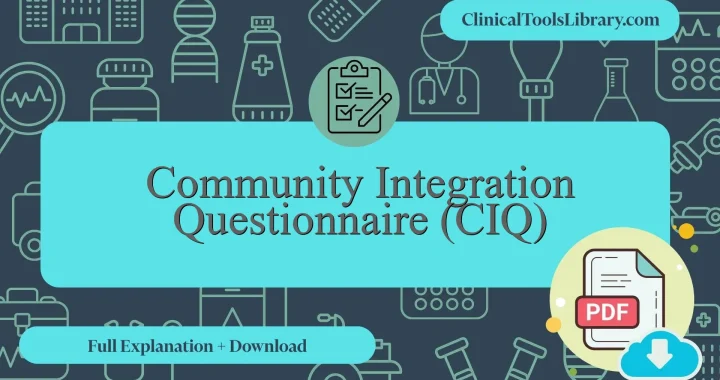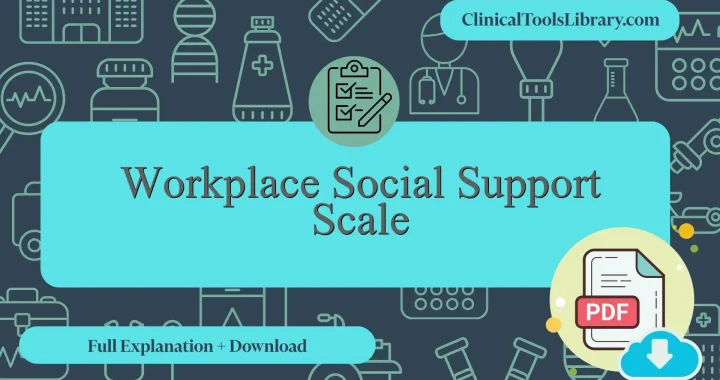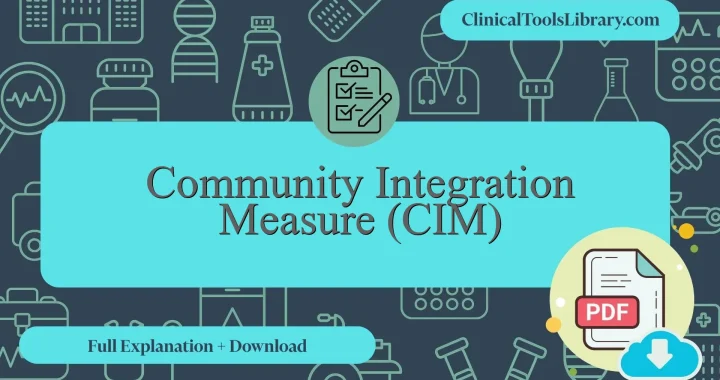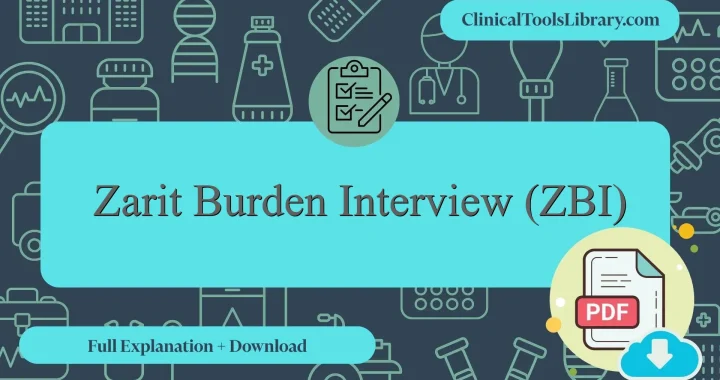In this article, we explain everything you need to know about the Community Integration Questionnaire (CIQ). We will cover the aspects it evaluates, the target population, a detailed step-by-step explanation, and how to interpret its results. Additionally, we will dive into the scientific evidence supporting this tool (diagnostic sensitivity and specificity) in clinical assessment. You will also find official and unofficial sources available for download in PDF format.
What does the Community Integration Questionnaire (CIQ) assess?
The Community Integration Questionnaire (CIQ) is a standardized tool designed to evaluate an individual’s level of participation in various domains of community living, including home integration, social integration, and productive activities. Primarily utilized in rehabilitation settings, it assesses the extent to which patients with neurological disorders or traumatic brain injury reintegrate into social roles and perform daily activities independently. The CIQ scoring system quantifies these aspects, providing objective data to guide treatment planning and monitor progress. The questionnaire is often employed alongside other measures such as the Social Integration Scale to deliver comprehensive assessments of community engagement. Versions of the Community Integration Questionnaire CIQ PDF and online formats ensure accessibility for clinicians and researchers seeking reliable outcome measures.
For which type of patients or populations is the Community Integration Questionnaire (CIQ) intended?
The Community Integration Questionnaire (CIQ) is primarily indicated for patients with traumatic brain injury (TBI), stroke, and other forms of acquired brain injury to assess their level of community engagement and social integration. It is extensively utilized in rehabilitation settings to evaluate functional outcomes related to home integration, social interactions, and productivity. The tool’s structured format facilitates objective measurement of a patient’s ability to resume roles within their community, thereby informing tailored intervention plans. Its application is especially valuable in outpatient and post-acute care environments where goal-setting and progress tracking are critical. Clinicians rely on Community integration questionnaire CIQ scoring to quantify participation levels, making it a robust instrument for research and clinical practice in neurorehabilitation.
Step-by-Step Explanation of the Community Integration Questionnaire (CIQ)
The Community Integration Questionnaire (CIQ) consists of 15 items designed to assess a patient’s level of community integration across three domains: home integration, social integration, and productive activities. The instrument includes a combination of multiple-choice and yes/no questions, enabling evaluators to capture frequency and participation in various activities. Responses are typically scored on ordinal scales reflecting the degree of involvement, such as daily, weekly, or monthly engagement. Administrators should ensure that instructions are clearly communicated to respondents, and that items related to social participation address activities outside the home, while productively oriented questions focus on work, school, or volunteer involvement. The CIQ is particularly valuable in monitoring recovery and outcomes for individuals with traumatic brain injury and other neurological conditions, providing quantifiable data on community reentry and independence.
Downloadable Community Integration Questionnaire (CIQ) PDF and Scoring Guidelines Resources
Downloadable resources for the Community Integration Questionnaire (CIQ) PDF are available below, including both the original and English versions to facilitate comprehensive assessment. These materials support healthcare professionals in evaluating patient progress through standardized tools, ensuring accurate measurement of social integration. The provision of the Community Integration Questionnaire CIQ scoring guidelines alongside the questionnaires enhances the utility of the resources for clinical and research applications.
How to interpret the results of the Community Integration Questionnaire (CIQ)?
Interpretation of the Community Integration Questionnaire (CIQ) involves analyzing the total and subscale scores against established reference values, typically ranging from 0 to 29, where higher scores indicate better community integration post-injury or illness. Scores are divided into three domains: home integration, social integration, and productive activities. For example, a total CIQ score below 15 may suggest significant limitations in social reintegration, which is critical for patients recovering from traumatic brain injury or stroke. The formula to calculate the total score is the sum of the three subscale scores: Total CIQ = Home + Social + Productivity. Clinically, low scores alert healthcare professionals to potential barriers in daily functioning and facilitate targeted interventions aimed at enhancing independence and quality of life. Understanding CIQ results enables practitioners to tailor rehabilitation plans, monitor progress, and allocate resources effectively for improved patient outcomes.
What scientific evidence supports the Community Integration Questionnaire (CIQ) ?
The Community Integration Questionnaire (CIQ) was originally developed in the 1990s to assess social role participation following traumatic brain injury (TBI). Validation studies have demonstrated strong psychometric properties, including high internal consistency (Cronbach’s alpha > 0.7) and test-retest reliability. Research involving diverse populations, including individuals with stroke, spinal cord injury, and multiple sclerosis, has confirmed its sensitivity in capturing various dimensions of community integration, such as home competency, social integration, and productive activities. Construct validity has been supported by significant correlations with measures of functional independence and quality of life, while factor analyses have consistently identified coherent subscales corresponding to distinct community participation domains. These scientific evaluations substantiate the CIQ’s utility as a reliable and valid instrument for quantifying community reintegration outcomes in rehabilitation settings.
Diagnostic Accuracy: Sensitivity and Specificity of the Community Integration Questionnaire (CIQ)
The Community Integration Questionnaire (CIQ) demonstrates variable sensitivity and specificity depending on the population studied and the criterion measures employed. Research indicates that the CIQ typically achieves a sensitivity of approximately 78% to 85% in detecting difficulties with community integration among individuals with traumatic brain injury (TBI). Specificity values tend to range between 70% and 80%, reflecting its accuracy in correctly identifying those without community integration impairments. These psychometric properties support its utility as a screening tool rather than a definitive diagnostic measure, emphasizing the need for complementary assessments to ensure comprehensive evaluation.
Related Scales or Questionnaires
The Community Integration Questionnaire (CIQ) shares conceptual similarities with tools such as the Social Integration Scale, the Craig Handicap Assessment and Reporting Technique (CHART), and the Reintegration to Normal Living Index (RNLI). The Social Integration Scale, also available on ClinicalToolsLibrary.com, provides a broader assessment of social participation but may lack the CIQ’s specificity regarding home and community activities. CHART offers a multidimensional approach including physical and cognitive independence, which complements but does not replace the targeted community integration focus of the CIQ; its length can, however, limit clinical utility. The RNLI emphasizes perceived reintegration and subjective quality of life, contrasting with the CIQ’s objective behavioral metrics. Each instrument, including the Community integration questionnaire ciq pdf and scoring methodologies provided on the site, has strengths and drawbacks depending on the clinical context, especially for populations with stroke, traumatic brain injury, or spinal cord injury. These scales and questionnaires are thoroughly explained and available for download on ClinicalToolsLibrary.com for a comprehensive understanding of their application and interpretation.




